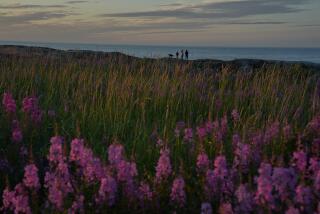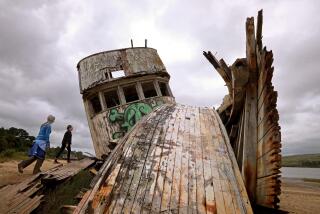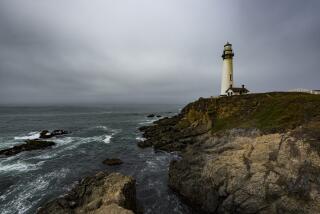The Ferry Stops Here
- Share via
ABOARD THE QUEEN OF THE CHILLIWACK — The stubby bow of the Queen of Chilliwack plunged into swells rolling in from the North Pacific as we steamed through the summer night. Dishes clanked in the galley.
We were heading north, crossing the open waters of Queen Charlotte Sound on Canada’s west coast an hour after departing from Port Hardy on the northern tip of British Columbia’s Vancouver Island.
The little ferry would soon turn east into Fitz Hugh Sound, one of many water-filled canyons that zigzag through the cloud-piercing mountains towering over the central B.C. coast.
I was on a three-day trip last June into some isolated villages previously reachable only by private boat or floatplane. A few weeks before, the Chilliwack inaugurated public service, linking Finn Bay, Namu, McLoughlin Bay (and Bella Bella), Shearwater, Ocean Falls, Bella Coola and Klemtu with the outside world.
I’d long wanted to see those villages, the people and the landscape up close. This working ferry, whose primary mission was to move goods and transport locals, was my chance. It wouldn’t be a pleasure cruise--sleeping accommodations were one of 120 recliner seats, or the floor; I’d have to use public showers, eat cafeteria food--but that was the beauty of it.
The 200-mile trip between Port Hardy and Bella Coola (via the Bella Bella area) took 22 hours. The ferry stops at each village averaged 1 1/2 hours, long enough for passengers to make shore excursions. The ferry makes four trips each week (over several routings) connecting the stops, so longer stopovers for fishing, boating, camping or hiking are easily accomplished. There are usually between 50 and 100 passengers. The service runs May through the end of September.
Sea gulls were screeching at dawn in the harbor of Namu. The 9,000-year-old former Indian village that once boomed with commercial fishing was empty and silent. Its fish processing business is now defunct.
Passengers watched as the ferry stood offshore and disgorged a lone kayaker, Jennifer Hahn of Bellingham, Wash., into the harbor’s water. She was embarking on a 75-mile trip back to Port Hardy. The previous summer she had paddled 350 miles from Alaska to Namu.
But Guy Thorn, of Powell River, B.C., ignored the lonely kayaker for the ghosts of his former fishing life.
“I fished this coast all my life,” he said, looking at the empty village. “I was a fish buyer here in the ‘40s and ‘50s, from Namu down to Rivers Inlet. Sockeye were 45 cents apiece.”
*
A commanding man with piercing eyes, Thorn was born on northern B.C.’s remote Nass River in 1922, the son of an Anglican minister. “Namu was wall-to-wall boats on every dock you can see,” he said. “We all knew each other. The place was jumping.”
Hahn paddled past Thorn’s memories, around the abandoned cannery, and disappeared into the mist.
The morning mist was still skittering around some islets called Fog Rocks in Fisher Channel, just north of Fitz Hugh Sound, when we saw 30 dolphins surface. We were well into the landscape of the Heiltsuk Nation, 100 miles from Port Hardy, nearing Bella Bella.
In 1793, just after becoming the first European to cross Canada, Alexander Mackenzie was confronted with the fierce territoriality of the Bella Bella--or Heiltsuk--people. In sea canoes they kept his Indian paddlers from the Bella Coola tribe from transporting him across Heiltsuk waters to view the open Pacific.
Mackenzie subsequently painted his name on a rock in nearby Dean Channel and returned overland to Montreal. Today, the tribal elders of Bella Bella still want no visitors. As we landed at McLoughlin Bay, two miles south of Bella Bella, an announcement was made to that effect. Bella Bella’s business is fishing, not tourism.
But Frank Brown, a young Bella Bella Heiltsuk, and his wife, Kathy, open the door a bit. From McLoughlin Bay, during a ferry layover, they give interested passengers a tour of Heiltsuk life.
We walked past sites of ancient occupation--before European settlement a Heiltsuk village was situated here--and visited a salmon hatchery. By a pond, Brown put out his arm and stopped us. He pointed down at steaming bear droppings, then looked upstream, downstream, and into dense blueberry and salmonberry lining the path.
Questions quickly shifted to bear habits. “Unlike grizzlies, local black bear usually spook from people,” Brown said. “Trouble comes when they are taking salmon or escorting cubs.” During the next hour’s walk we took turns being cub scouts, but we saw no bears.
Brown has built a small interpretive center in a replica of a traditional Heiltsuk long house on the bay’s urchin-shell beach. The long house, a fish plant and the ferry landing are the only other structures at McLoughlin Bay.
We discussed Heiltsuk sea voyages and exploits until a husky Bella Bella crew chief, Duane Walkus, began pulling out carved paddles for the nine of us who’d signed up for a four-mile canoe excursion. Our plan was to catch up with the ferry at Shearwater, its next stop.
The six men and three women paddlers leaped to their mission. With a few war whoops, we rocketed off in the canoe, charging through the wake of a gill net fishing boat, sending spray flying. The 30-foot dugout was surprisingly maneuverable and speedy.
We went out of our way to get a close look at Bella Bella’s waterfront and were late for the ferry. Its whistle sounded angrily as we rounded its stern and came into view.
Third mate Clive Quigley sang sea chanteys as the ferry left Shearwater. People played cards and toured the engine room or the bridge. It was an unusual, cloud-free day. There was a halibut barbecue on deck. A pod of 15 orcas vented silvery mist as they encircled a school of salmon in Lama Passage.
After the Shearwater stop, snowy peaks of the Coast Range began to appear on the skyline as we neared Ocean Falls, 30 miles northeast of Bella Bella. A group of ravens began chasing a bald eagle around a cedar.
Once a booming pulp mill town of 5,000, Ocean Falls became a ghost town after the mill shut in 1980. Most buildings are still intact. The area population is now 65. Four people live in the old town itself, including Diana MacLean, who was coming home after a month “outside.”
Nearing town, the dark-haired woman gathered a crowd on the forward deck with her raucous voice. She dispensed facts, poignant history and local color, and pointed out landmarks, all the while competing with the ship’s loudspeaker, which was broadcasting a cleaned up and watered down version.
Bella Coola is tucked into the Coast Range 65 miles east of Bella Bella. It begins at the end of a channel where the Bella Coola River empties into saltwater, and stretches two miles upriver to the town center. Approaching it, the ferry zigzags through fiords where mountains soar and waterfalls stream out of the clouds. Interior rivers, such as the Bella Coola, have created valleys and deltas where moose, grizzlies and huge salmon runs flourish.
*
About 2,500 people live in Bella Coola and the surrounding area. It is the ancient home of the Bella Coola--or Nuxalk--people. When Mackenzie came to this lush place one summer evening in 1793, completing his epic journey across North America, the Nuxalks accepted him, feasted him on roast salmon and provided him lodging.
In 1858, tens of thousands of miners went through the Bella Coola River valley to a major gold strike in central British Columbia’s Cariboo region. England established a Hudson’s Bay fur trading outpost here in 1867. Through it runs the 300-mile-long Canadian Highway 20 to Williams Lake and the interior.
Darren Edgar is a Nuxalk guide. A slight, congenial man, he popped out from behind a totem pole just as I arrived in town. I would stay overnight as the ferry would lay over until 8 a.m. the next day. Edgar welcomed me to his valley, told me I could camp on the delta, but that it was full of bears; that there were inns and cafes in town; that salmon were running, and that orcas, seals and eagles were feasting on them.
As we talked I watched the glaciers atop 8,400-foot Nusatsum Mountain disappear as storm clouds swept over them and down the river valley. Edgar told me of some unusual petroglyphs he guided to, and gave me his card. It said: “Good Will Ambassador.”
Later, out of the rain at the Cedar Inn, proprietor Ken Smith told me “the old village site that Mackenzie visited 200 years ago was abandoned when the river moved.” He said that there was a mix of Bella Coola Nuxalks, Scandinavians, Scots, French, English, Hungarian and other recent immigrants. Norwegians came in large numbers to colonize in 1894. About a third of the population is Nuxalk.
People started arriving at dawn the next day for the 8 a.m. ferry. Five kayakers drove in from Seattle. They were off to Finn Bay and the outer coast Hakai Recreation Area. Trucks rolled in from the Chilcotin plateau to the east.
A group of disembarking Japanese tourists who had slept on the Chilliwack began retrieving their gear from the luggage cart. Goodwill ambassador Darren Edgar popped out of the shadows, talked a bit, then gave them his business card.
*
A summer storm was buffeting Klemtu, the northernmost village on the ferry’s run and the southernmost in the range of the native Tsimshian peoples. But the children surrounding the dock hardly noticed the weather. They watched eagerly as the ferry made its way up the channel, through sheets of rain, toward its landing. From their excitement, I guessed they all had relatives or packages or something important coming in.
A shrimp-fishing boat was getting fuel at the oil dock. It rocked in the wake of a herring boat as it came in from neighboring Princess Royal Island. Five Alaska salmon seiners steamed by the village, heading north. Up the silvery boardwalk, people loitered in the Band Store and Cafe, the only eatery in town.
The ferry docked. The kids swarmed on. On the car deck they piled onto the forklift, tow van and luggage carts, tooting horns, flicking lights. They massed upstairs at the steward’s service office for an official tour then broke off, one by one, toward what they’d really come for: the video games arcade and snack-machine room. To them, the ferry was the great white floating mall that came in every eight days. After about two hours, mothers and aunties came and led them home.
We left Klemtu in a southeast gale at 3 a.m., reaching the open Pacific for a 10-mile crossing of Milbanke Sound. Huge swells, 20-footers at least, smacked us head on. The bow dipped and the Chilliwack took green water over the observation deck. Rain came in torrents and sea gulls were blown across the sky. Whitecaps stretched into the distance.
All of a sudden, a cheery voice came over the intercom. “First call for breakfast. This morning we have pancakes, omelets, sausages, hash browns, pigs in a poke, ham and eggs, and good old bacon and eggs. Bon appetit.” I looked over at the man next to me. He had his ears plugged.
We were still rolling when we turned inside to stop at McLoughlin Bay. Two kayakers got on carrying their battered 16 foot boats, looking shell-shocked. Late in the afternoon we left the protection of Fitz Hugh Sound and began our 40-mile open ocean crossing of Queen Charlotte Sound, heading back to our starting point of Port Hardy. Storm waves were booming against the boulders as we passed the Egg Island lighthouse. Spray shot high in the air, reaching toward its flashing beacon. Three decades earlier a storm had washed the buildings that housed the lightkeeper into the sea.
We rolled into Port Hardy in the evening. It was still quite bumpy. As I stepped off, I wished the third mate and two deckhands, who were beating on bent shackles, a pleasant evening. They tried not to scowl. They were heading back out on the Chilliwack in just two hours.
(BEGIN TEXT OF INFOBOX / INFOGRAPHIC)
GUIDEBOOK
Fair Ports in British Columbia
If you go: Queen of Chilliwack is operated by British Columbia Ferry Corp.; it is 376 feet long, and carries a maximum of 375 passengers and 115 cars. There are no private rooms but the lounge has 120 recliner seats; many passengers bunk down with sleeping bags between rows. The ferry has showers, a cafeteria, bar and video game arcade. Itineraries: Various departure times from Port Hardy, May 26 through Sept. 29. Voyages include stops at mid-coast communities or more direct service with same-night arrivals (either 10 or 11 p.m.) at Bella Coola. A typical eight-day period will include four ferry stops each at Port Hardy, Bella Coola, McLoughlin Bay, Shearwater, Ocean Falls and Namu, and one at Klemtu.
Costs: Typical fares from Port Hardy to Bella Coola are about $85 per adult, plus $175 for cars or $220 for RVs. From Port Hardy to McLoughlin Bay (Bella Bella), the fare is $55 per adult. Children 5-11 are half price; under 5 ride free. Reservations are recommended.
Getting there: To get to Port Hardy from Seattle, drive north to Tsawwassen, B.C. (about three hours), take the ferry to Nanaimo (two hours), then drive north on British Columbia Highway 19 to Port Hardy, (245 miles). Excursions: All shore excursions can be booked on the ferry. Klemtu: Historical Cultural Tour, followed by salmon buffet dinner and native dancing, $30. McLoughlin Bay: Walking tour to Bella Bella salmon hatchery and fish plant, $15; canoe tour, $35. Contact Frank and Kathy Brown at See-Quest Tours, telephone (604) 957-2774. Shearwater: Shearwater Marine Resort, tel. (604) 270-6204, offers cruise and fishing trip on 43-foot yacht, $100 to $120, including lunch. Bella Coola: Stopover usually required to tour area. Call Freedom Highway Tourism Assn., tel. (604) 982-2312.
For more information: British Columbia Ferry Corp., 1112 Fort St., Victoria, B.C., Canada V8V4V2; tel. (250) 386-3431; in Vancouver, tel. (604) 669-1211. Discover British Columbia, the province’s tourism office, (800) 663-6000.
More to Read
Sign up for The Wild
We’ll help you find the best places to hike, bike and run, as well as the perfect silent spots for meditation and yoga.
You may occasionally receive promotional content from the Los Angeles Times.






